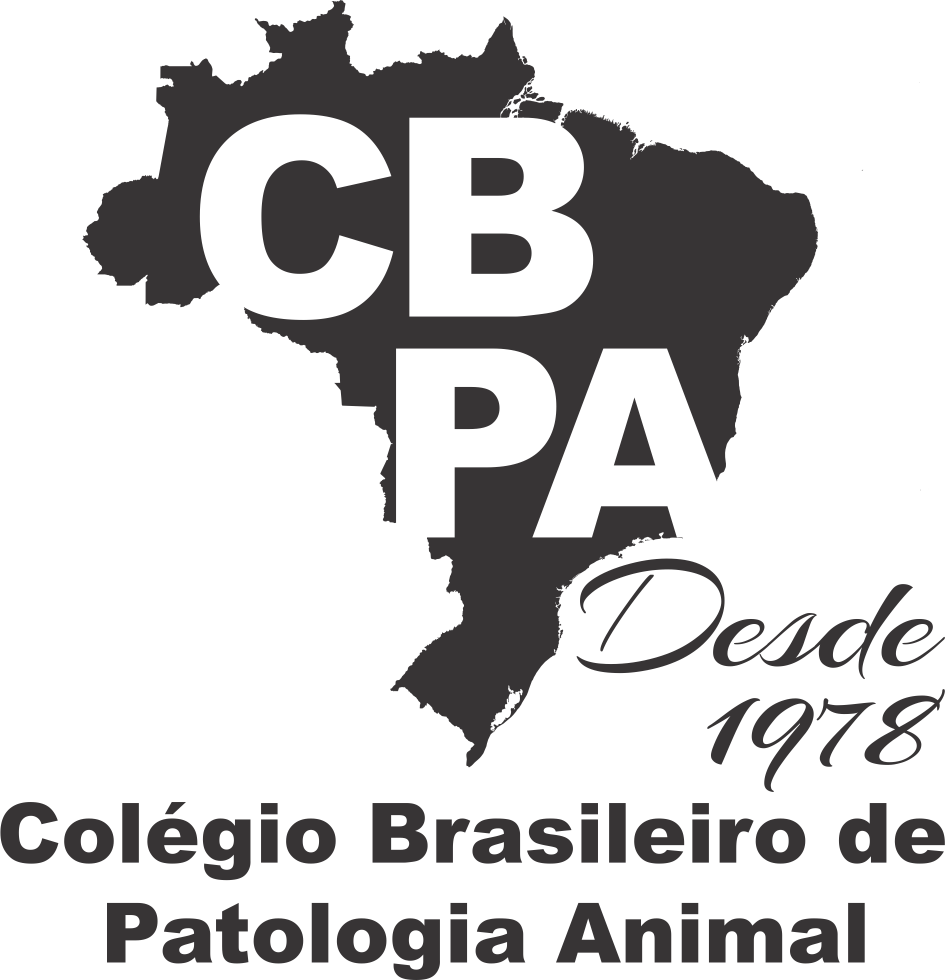Resultado da pesquisa (3)
Termo utilizado na pesquisa onfalopatia
#1 - Serum immunoglobulin from Nellore cattle produced by in vitro fertilization and treated for umbilical diseases
Abstract in English:
The aim of this study was to measure serum immunoglobulin concentrations of Nellore cattle produced by in vitro fertilization (IVF) with umbilical diseases and to evaluate surgical excision as a method of treatment. Sixteen cattle with ages ranging from 1 to 15 months, males and females, affected by umbilical diseases were enrolled in the study. Blood samples were collected for cell counts and the determination of immunoglobulin concentrations by electrophoresis and zinc sulphate turbidimetry (ZST). Four calves were presented with umbilical herniation, two with an umbilical herniation associated with a persistent urachus, two with an umbilical herniation with a persistent urachus and omphaloarteritis, three with an umbilical herniation and an urachal diverticulum, three with a persistent urachus, one with an urachal diverticulum, and one with omphalitis. The blood cell counts pre- and post-surgical revealed differences in cell volume and the number of leukocytes. The immunoglobulin values measured by electrophoresis values were below normal in most animals, whereas the ZST showed normal levels in most of them. Most of the calves affected by umbilical diseases and produced by IVF presented hypoglobulinaemia. Correlations between umbilical diseases, failure of passive transfer of immunity and IVF could not be demonstrated.
Abstract in Portuguese:
Os objetivos desse estudo foram mensurar as concentrações séricas das imunoglobulinas de bovinos Nelore, produzidos por fertilização in vitro (FIV), acometidos por onfalopatias e avaliar a excisão cirúrgica como método de tratamento. Utilizou-se 16 animais, com idade variando de 1 a 15 meses, machos e fêmeas, acometidos por afecções umbilicais. Amostras de sangue foram colhidas para realização de hemogramas e avaliação das imunoglobulinas, por meio de eletroforese e turbidimetria com sulfato de zinco. Foram observados quatro casos de hérnias umbilicais, dois de hérnia umbilical associadas à persistência de úraco, dois casos de hérnia umbilical com persistência de úraco e onfaloarterite, três de hérnia umbilical com divertículo de úraco, três casos de persistência de úraco, um de divertículo de úraco e um de onfalite. O hemograma revelou diferença significativa para os valores de Volume Globular e Leucócitos, nos momentos pré e pós-tratamento cirúrgico dos animais. A eletroforese evidenciou valores de imunoglobulina abaixo da normalidade na maioria dos animais, enquanto que a turbidimetria apresentou níveis normais na maioria dos bovinos, quando comparados com valores de referência. A maioria dos bovinos estudados, acometidos de onfalopatias e concebidos por FIV, apresentaram hipoglobulinemia. Os resultados obtidos não permitem afirmar que existe relação entre as onfalopatias, falha de transferência de imunidade passiva e FIV.
#2 - Ultrassonographic avaliation of the inflamed umbilical structures in Holstein calves during their first 30 days of life, 36(6):492-502
Abstract in English:
ABSTRACT.- Seino C.H., Bombardelli J.A., Reis G.A., Santos R.B., Shecaira C.L., Azedo M.R. & Benesi F.J. 2016. [Ultrassonographic avaliation of the inflamed umbilical structures in Holstein calves during their first 30 days of life.] Avaliação ultrassonográfica de componentes umbilicais inflamados em bezerros da raça Holandesa com até 30 dias de vida. Pesquisa Veterinária Brasileira 36(6):492-502. Departamento de Clínica Médica. Faculdade de Medicina Veterinária e Zootecnia, Universidade de São Paulo, Av. Prof. Dr. Orlando Marques de Paiva 87, São Paulo, SP 05508-270, Brazil. E-mail: caroline.seino@gmail.com
Umbilical disorders deserve mention among the illnesses affecting calves in the first month of life. The high incidence during this phase of life of newborns and relevant economic losses arising from mortality, cost of treatment and veterinary care, beyond sequelae may determine lower weight gain and milk production. The diagnosis of these diseases is often hampered by the difficulty to detect the involvement of intra-abdominal umbilical structures, which negatively affect the choice of the most appropriate treatment and the actual outcome for each calf. In the present study, we performed ultrasound examinations of calves with inflammation/infection in the umbilical components and observed some characteristics related with measurements and echogenicity present in umbilical affected components. From these evaluation it was concluded that the wall thickness of the umbilical vessels is the more reliable standard to determine changes in these components, as compared with that of the diameter of the umbilical vessels. Furthermore, from this study we observed some peculiarities of involution of the intra-abdominal umbilical cord components in healthy Holstein calves used for the control group to characterize the behavior of the umbilical structures during the progress of the age in the newborns. It is noteworthy that the comparison of these results with those found in the rare literature available showed notable differences.
Abstract in Portuguese:
RESUMO.- Seino C.H., Bombardelli J.A., Reis G.A., Santos R.B., Shecaira C.L., Azedo M.R. & Benesi F.J. 2016. [Ultrassonographic avaliation of the inflamed umbilical structures in Holstein calves during their first 30 days of life.] Avaliação ultrassonográfica de componentes umbilicais inflamados em bezerros da raça Holandesa com até 30 dias de vida. Pesquisa Veterinária Brasileira 36(6):492-502. Departamento de Clínica Médica. Faculdade de Medicina Veterinária e Zootecnia, Universidade de São Paulo, Av. Prof. Dr. Orlando Marques de Paiva 87, São Paulo, SP 05508-270, Brazil. E-mail: caroline.seino@gmail.com
As afecções umbilicais merecem destaque entre as enfermidades que acometem bezerros no primeiro mês de vida, pela alta incidência durante essa fase da vida dos neonatos e pelas relevantes perdas econômicas, decorrentes da mortalidade, custos de tratamento e atendimento veterinário, além de sequelas que poderão determinar menores ganho de peso e produção leiteira. O diagnóstico dessas enfermidades muitas vezes é prejudicado pela dificuldade em se detectar os acometimentos das estruturas intra-abdominais do umbigo, o que afetará negativamente a escolha do tratamento mais adequado e o estabelecimento do real prognóstico para cada animal. No presente estudo, realizou-se a análise ultrassonográfica dos animais com inflamação/infecção dos componentes umbilicais sendo possível observar algumas características em relação a mensurações e ecogenicidade, presentes nos componentes umbilicais acometidos. A partir dessas avaliações concluiu-se que a medida mais adequada para identificar animais com possíveis processos inflamatórios nos componentes umbilicais é a espessura da parede dos vasos umbilicais quando comparada ao diâmetro dos mesmos. Ainda, o estudo possibilitou verificar algumas particularidades do comportamento dos componentes do cordão umbilical em bezerros sadios da raça Holandesa, bem como determinar que os vasos umbilicais intra-abdominais iniciam uma involução em porção mais interna e progridem para as extremidades próximas ao anel umbilical com o evoluir da idade. Destaca-se que o confronto desses resultados com aqueles poucos descritos na literatura disponível mostrou-se com notáveis diferenças.
#3 - Correlation between conception methods, occurrence, and type o treatment of the umbilical diseases in cattle: A retrospective study, 30(8):618-622
Abstract in English:
ABSTRACT.- Rodrigues C.A., Santos P.S.P., Perri S.H.V., Teodoro P.H.M., Anhesini C.R., Araújo M.A.. & Viana Filho M.N. 2010. [Correlation between conception methods, occurrence, and type o treatment of the umbilical diseases in cattle: A retrospective study.] Correlação entre os métodos de concepção, ocorrência e formas de tratamento das onfalopatias em bovinos: estudo retrospectivo. Pesquisa Veterinária Brasileira 30(8):618-622. Departamento de Cirurgia e Anestesiologia Veterinária, Faculdade de Medicina Veterinária e Zootecnia , Universidade Estadual Paulista “Júlio de Mesquita Filho” (Unesp), Campus de Botucatu, Distrito de Rubião Júnior s/n, Cx. Postal 560, Botucatu SP 18618-970, Brazil. E-mail: rodriguesca@fmvz.unesp.br
Some problems have been observed in bovine products of the in vitro fertilization technical, among these, the high umbilical diseases casuistry. From this observation, the aim of this work was to accomplish a retrospective study of the correlation between the conception methods and the occurrence of umbilical diseases in bovines and describe the results obtained from the conservative and surgical treatments. For this 44 animals attended at Veterinary Teaching Hospital of Unesp Araçatuba, with age varying from one day to 12 months among the years of 2003 and 2007 were used, twenty seven were from in vitro fertilization (IVF), twelve were from artificial insemination (AI), two were from natural mounts and three were from embryo transfer. The clinical-surgical diagnosis of the animals revealed that all of them presented umbilical disorders, being 22 cases of urachus patent, eight omphalophlebitis, eight umbilical hernia, five omphalitis and one umbilical fibrosis. Before and at the postoperative period was administered in all animals once a day for ten days 3mg/kg of ceftiofur sodium IV. In cases of serious infection or lack of response of the initial antimicrobial therapy a complementary treatment during seven days with 6.6 mg/kg of gentamicin sulfate IV was carried out. The antisepsis of the umbilicus with tincture of iodine to 2% was carried out twice daily in cases treated clinically, with out surgery, while the animals underwent surgery received 1.1mg/kg of flunixin meglumine IV once daily for five consecutive days.Among the 22 animals diagnosed with urachus patent, 10 had urine drainage from the umbilicus and received 2mL of 10% tincture of iodine in the urachus, and 15 was treated with surgical excision, due to formation of diverticulum from the blader to urachus. All animals that were affected with omphalophlebitis and umbilical hernia were submitted to surgery and already of the five cases of omphalitis, three were treated clinically. The analysis of different conception methods correlated to the umbilical diseases occurrence showed evidences that in this retrospective study, the animals from IVF have a higher frequency of the urachus patent (66.7%), and animals designed to AI observed higher frequency of umbilical hernia (58.4%). There is high correlation between the IVF and the occurrence of umbilical diseases in calves and the conservative therapy was effective in less complicated cases and quickly identified, while the surgical treatment showed better results in the cases studied.
Abstract in Portuguese:
RESUMO.- Rodrigues C.A., Santos P.S.P., Perri S.H.V., Teodoro P.H.M., Anhesini C.R., Araújo M.A.. & Viana Filho M.N. 2010. [Correlation between conception methods, occurrence, and type o treatment of the umbilical diseases in cattle: A retrospective study.] Correlação entre os métodos de concepção, ocorrência e formas de tratamento das onfalopatias em bovinos: estudo retrospectivo. Pesquisa Veterinária Brasileira 30(8):618-622. Departamento de Cirurgia e Anestesiologia Veterinária, Faculdade de Medicina Veterinária e Zootecnia , Universidade Estadual Paulista “Júlio de Mesquita Filho” (Unesp), Campus de Botucatu, Distrito de Rubião Júnior s/n, Cx. Postal 560, Botucatu SP 18618-970, Brazil. E-mail: rodriguesca@fmvz.unesp.br
Alguns problemas têm sido observados nos bezerros produtos da técnica fertilização in vitro, dentre esses a elevada casuística de onfalopatias. A partir dessa observação, objetivou-se com este trabalho realizar um estudo retrospectivo da correlação entre os métodos de concepção e a ocorrência de onfalopatias em bovinos e descrever os resultados obtidos a partir dos tratamentos conservativo e cirúrgico. Foram utilizados 44 bovinos atendidos no Hospital Veterinário da Unesp, Campus de Araçatuba, com idade variando de um dia a 12 meses entre os anos de 2003 e 2007. Desses bovinos 27 eram provenientes de fertilização in vitro (FIV), 12 de inseminação artificial (IA), dois de monta natural (MN) e três de transferência de embriões (TE). O diagnóstico clínico-cirúrgico revelou que todos apresentavam afecções umbilicais, sendo 22 casos de persistência de úraco, oito de onfaloflebite, oito de hérnias umbilicais, cinco de onfalites e um de fibrose umbilical. Inicialmente e no pós-operatório administrou-se em todos os animais, uma vez ao dia, durante dez dias, 3mg/kg de ceftiofur sódico pela via intravenosa (IV). Nos casos de infecção grave ou irresponsiva a terapia antimicrobiana inicial, acrescentou-se 6,6mg/kg, durante sete dias de sulfato de gentamicina IV. A antissepsia do umbigo, com tintura de iodo a 2%, foi instituída duas vezes ao dia, nos casos tratados conservativamente, enquanto que os bovinos submetidos à cirurgia receberam 1,1mg/kg de flunixin meglumine IV, uma vez ao dia, por cinco dias consecutivos. Dos 22 animais diagnosticados com persistência de úraco, 10 apresentavam drenagem de urina pelo umbigo e receberam 2mL de tintura de iodo 10% no interior do úraco, sendo 15 tratados com a excisão cirúrgica, especialmente, devido à formação de divertículo vésico-uracal. Todos os animais que apresentavam onfaloflebite e hérnia umbilical foram submetidos à cirurgia. Já dos cinco casos de onfalite, três foram tratados conservativamente. A análise dos diferentes métodos de concepção, correlacionados à ocorrência de onfalopatias, sugere que os animais provenientes de FIV, apresentam maior frequência de persistência de úraco (66,7%), e aqueles concebidos por IA, maior frequência de hérnia umbilical (58,4%), O tratamento cirúrgico foi mais eficiente que a terapia conservativa. Essa última apresentou melhores resultados nos casos descomplicados e precocemente diagnosticados.








